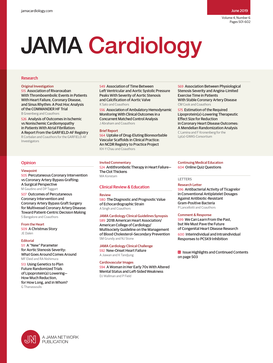Artificial Intelligence–Enhanced Electrocardiography for Complete Heart Block Risk Stratification
IF 14.1
1区 医学
Q1 CARDIAC & CARDIOVASCULAR SYSTEMS
引用次数: 0
Abstract
IntroductionComplete heart block (CHB) is a life-threatening condition that can lead to ventricular standstill, syncopal injury, and sudden cardiac death, and current electrocardiography (ECG)-based risk stratification (presence of bifascicular block) is crude and has limited performance. Artificial intelligence–enhanced electrocardiography (AI-ECG) has been shown to identify a broad spectrum of subclinical disease and may be useful for CHB.ObjectiveTo develop an AI-ECG risk estimator for CHB (AIRE-CHB) to predict incident CHB.Design, Setting, and ParticipantsThis cohort study was a development and external validation prognostic study conducted at Beth Israel Deaconess Medical Center and validated externally in the UK Biobank volunteer cohort.ExposureElectrocardiogram.Main Outcomes and MeasuresA new diagnosis of CHB more than 31 days after the ECG. AIRE-CHB uses a residual convolutional neural network architecture with a discrete-time survival loss function and was trained to predict incident CHB.ResultsThe Beth Israel Deaconess Medical Center cohort included 1 163 401 ECGs from 189 539 patients. AIRE-CHB predicted incident CHB with a C index of 0.836 (95% CI, 0.819-0.534) and area under the receiver operating characteristics curve (AUROC) for incident CHB within 1 year of 0.889 (95% CI, 0.863-0.916). In comparison, the presence of bifascicular block had an AUROC of 0.594 (95% CI, 0.567-0.620). Participants in the high-risk quartile had an adjusted hazard ratio (aHR) of 11.6 (95% CI, 7.62-17.7;人工智能增强心电图对完全心脏传导阻滞风险分层的影响
完全性心脏传导阻滞(CHB)是一种危及生命的疾病,可导致心室停滞、晕厥损伤和心源性猝死,目前基于心电图(ECG)的风险分层(存在双束传导阻滞)是粗糙的,效果有限。人工智能增强心电图(AI-ECG)已被证明可以识别广泛的亚临床疾病,并可能对慢性乙型肝炎有用。目的建立AI-ECG CHB风险评估器(AIRE-CHB),预测CHB的发生。设计、环境和参与者本队列研究是在Beth Israel Deaconess医疗中心进行的一项开发和外部验证预后研究,并在英国生物银行志愿者队列中进行了外部验证。暴露心电图:主要结果和测量心电图检查后31天以上新诊断为CHB。AIRE-CHB使用带有离散时间生存损失函数的残差卷积神经网络架构,并经过训练来预测事件CHB。结果贝斯以色列女执事医疗中心队列共纳入189 539例患者的1 163 401例心电图。AIRE-CHB预测CHB发生的C指数为0.836 (95% CI, 0.819-0.534), 1年内CHB发生的受试者工作特征曲线下面积(AUROC)为0.889 (95% CI, 0.863-0.916)。相比之下,双束阻滞的AUROC为0.594 (95% CI, 0.567-0.620)。高危四分位数的参与者调整后的风险比(aHR)为11.6 (95% CI, 7.62-17.7; P <)001)与低风险组相比,发生CHB的风险更大。在UKB UK Biobank队列中,来自189539例患者的50641个心电图,预测CHB事件的C指数为0.936 (95% CI, 0.900-0.972), aHR为7.17 (95% CI, 1.67-30.81; P & lt; .001)。结论和相关性在本研究中,首次使用了深度学习模型来识别CHB事件的风险。AIRE-CHB可用于多种情况,以帮助晕厥或有高级别房室传导阻滞风险的个体做出决策。
本文章由计算机程序翻译,如有差异,请以英文原文为准。
求助全文
约1分钟内获得全文
求助全文
来源期刊

JAMA cardiology
Medicine-Cardiology and Cardiovascular Medicine
CiteScore
45.80
自引率
1.70%
发文量
264
期刊介绍:
JAMA Cardiology, an international peer-reviewed journal, serves as the premier publication for clinical investigators, clinicians, and trainees in cardiovascular medicine worldwide. As a member of the JAMA Network, it aligns with a consortium of peer-reviewed general medical and specialty publications.
Published online weekly, every Wednesday, and in 12 print/online issues annually, JAMA Cardiology attracts over 4.3 million annual article views and downloads. Research articles become freely accessible online 12 months post-publication without any author fees. Moreover, the online version is readily accessible to institutions in developing countries through the World Health Organization's HINARI program.
Positioned at the intersection of clinical investigation, actionable clinical science, and clinical practice, JAMA Cardiology prioritizes traditional and evolving cardiovascular medicine, alongside evidence-based health policy. It places particular emphasis on health equity, especially when grounded in original science, as a top editorial priority.
 求助内容:
求助内容: 应助结果提醒方式:
应助结果提醒方式:


